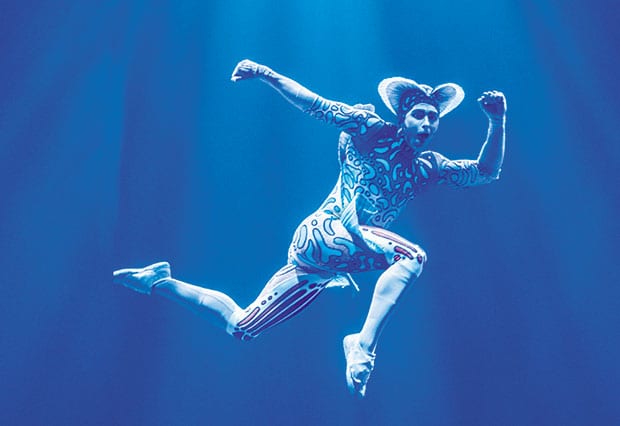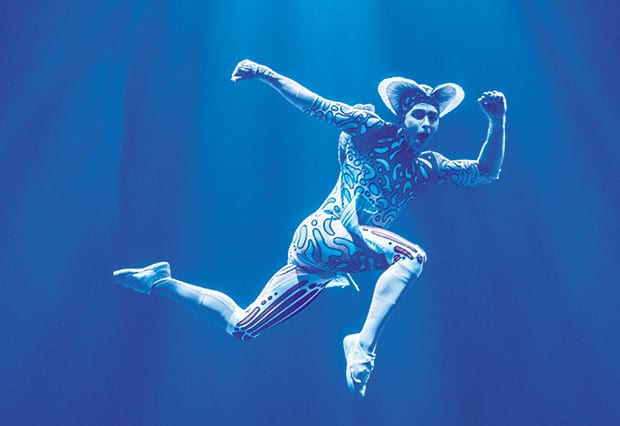We chat with Nathan Dennis, one of the out artists with Cirque du Soleil’s newest show, ‘Kurios — Cabinet of Curiosities’

It’s a cliché that at some point, all young boys dream of running away to join the circus. A circus. Any circus. You’d think it hasn’t actually happened since the Great Depression. But for Nathan Dennis, not only is it literally true, it is exactly the future he imagined.
“I saw a Cirque du Soleil show when I was about 13,” recalls the native of Brisbane in Queensland, Australia. The show was one of Cirque’s earliest touring productions: Saltimbanco. “I said to my mother that I would really like to do that. My mom thought I was a little crazy but I wanted run away with the circus.”
But what exactly was the “that” they were doing, and how does a tween prepare for a career in the circus? Dennis was pretty savvy about it.
“I made the link between what I saw [under the big top], and gymnastics,” he says. “When I was younger, I was always hand-standing and was a little bit acrobatic.” But he immediately began taking formal gymnastics classes, perfecting his tumbles and jumps and stretches — all with one goal: To join Cirque du Soleil.
 “My main background was trampoline, so [I felt comfortable applying that to] all the acts in Cirque that involve an aerial element. That’s how I made the link. If I had good aerial awareness, I could do a double somersault from a swing or a trapeze.”
“My main background was trampoline, so [I felt comfortable applying that to] all the acts in Cirque that involve an aerial element. That’s how I made the link. If I had good aerial awareness, I could do a double somersault from a swing or a trapeze.”
Ummm… Aerial awareness? Explain for us couch potatoes, please. Dennis laughs.
“It’s pretty much just have a good ability to know where you are when in the air,” he explains. “To [execute] which trick you are doing, you need to be a little fearless, as well. It all comes naturally to me.”
After years of practice, once he finished high school, he auditioned.
And he was hired.
For Saltimbanco — the very show that triggered his fascination in the first place.
Talk about lightning in a bottle.
That was, remarkably, about a decade ago. In the intervening time, Dennis has moved into one of Cirque’s newest productions: Kurios — Cabinet of Curiosities, which is now in its more than month-long run under the distinctive colorful tent at Lone Star Park in Grand Prairie. And while Dennis has been with the show for nearly three years, the run-up to it has been a lengthy and daunting undertaking.
Ever wonder how the creative folks at Cirque du Soleil put together a new show from soup to nuts? Dennis has lived it.
Cirque management had begun to hear feedback that, after 30 years of performances, their shows were becoming a little predictable. To address that, the director and writer of the show, Michel Laprise, declared a mandate: Get rid of what they were doing out of habit versus what they did out of necessity (safety, for instance). The result is Kurios.
One thing that sets apart the act Dennis is a part of, called AcroNet, is that just a few years ago, much of what you see would not have been possible. Advances in technology made the trampoline rigging a reality. What arrives on stage looks like a music box, and out of it, the characters come to life (Dennis is one of six performers in the act). They then dazzle us with a human-powered display of physicality.
“When we practiced in our high school gym it was never on this scale,” Dennis says, still slightly amazed at what they are able to do. “I was definitely excited when they said we have this new project. I didn’t envision the net whatsoever.”
All of that required not just tons of training, but the ability to design a unique and entertaining act.
Dennis was plucked from Saltimbanco to join five other artists — none of whom he knew personally, only by reputation on their work in other Cirque productions — to develop the act together.
First, they had to learn how to use the net itself, and to develop their leg strength and control the net with their feet. Then they needed to turn those skills into something.
“For the first two months, we paired with a choreographer and acrobatics coach, and they put together a rough draft of the act. Then we presented it to the artistic director. We’d go back and forth until he liked what he saw. The full creation period was nine months — a week before we premiered, we were still changing things. And we’re still developing stuff now,” he says. “I still don’t know how [we] pulled it off.”
AcroNet has proven popular with audiences of all ages — the costumes (a distinctive aspect of all Cirque shows) conjure up fishes either in a net or buoyantly swimming through the “water,” behaving with goofy abandon. All of which seems very “Cirque du Soleil” to Dennis.
“I just think that there’s an attention to detail and it’s the small details that make the shows stand out,” says. There’s even an LGBT moment in the show, inserted by Laprise (who, like Dennis, is openly gay) where he puts a rainbow in the show — a wink to the big queer following Cirque has always enjoyed.
Just before the Dallas production opened, Dennis and the rest of the cast were on a break, which allowed him to return to his family in Australia. Now that he’s 30, he realizes that his dream job comes at a cost.
“I was dating someone in Australia, but I do not [have a partner] now. It’s hard to meet people and maintain a relationship — especially when you are leaving and going to a city far away, it’s kind of draining to manage,” he says.
Ah, life in a circus. It’s not all clowns and rainbows.
This article appeared in the Dallas Voice print edition February, 17 2017.











